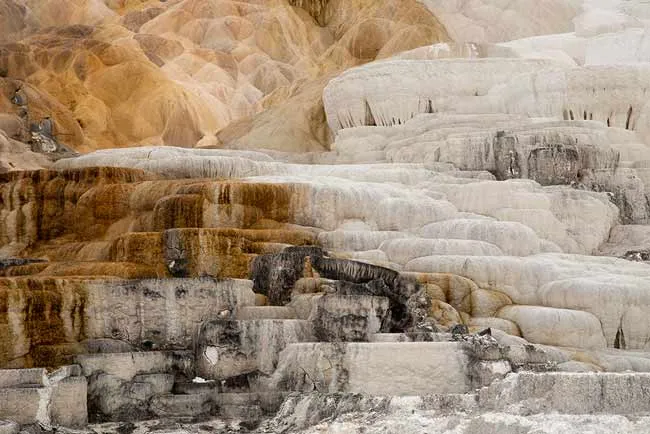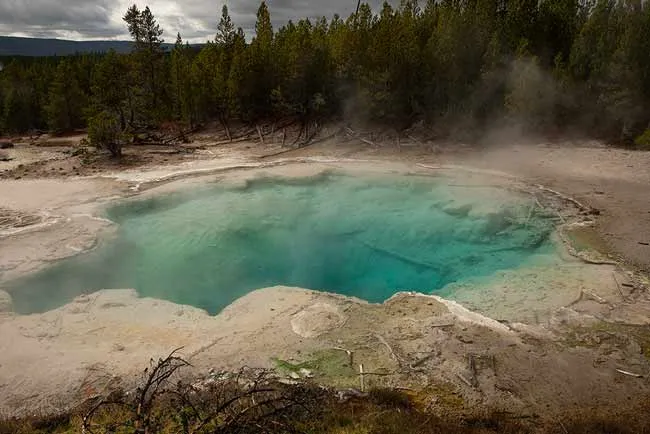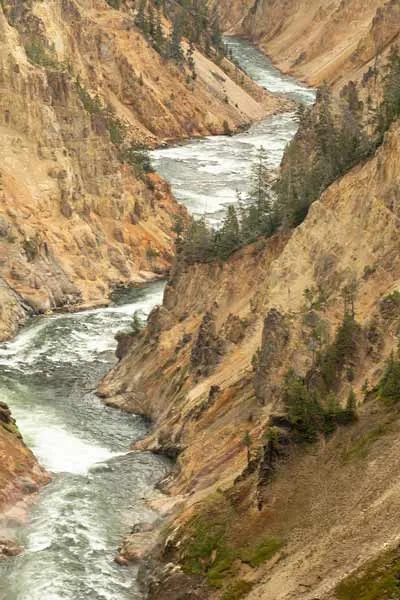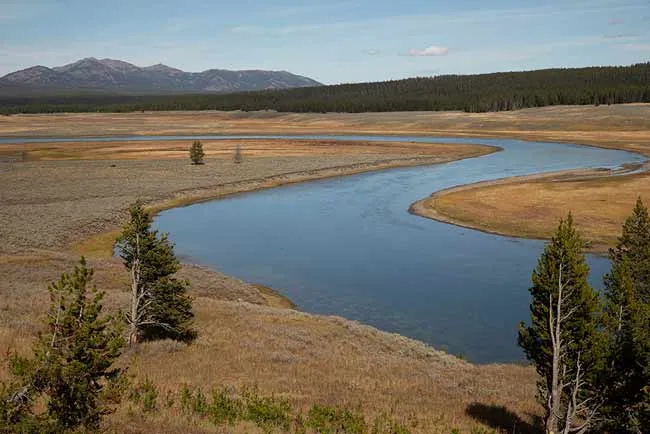Yellowstone, the jewel of America, is not only the first national park but also a priceless natural treasure trove with countless geothermal wonders, diverse wildlife, and majestic landscapes. In the heart of this vast park, the Yellowstone River meanders like a green silk ribbon, playing the role of a lifeline nurturing life and creating unique exploration journeys. Traveling along the Yellowstone River route is not just a trip, but also an opportunity to immerse yourself in pristine nature, admire the masterpieces bestowed by creation, and experience unforgettable adventures with family and friends.
Discover the Beauty Along the Yellowstone River
The Yellowstone River originates from Yellowstone Lake, the largest high-elevation freshwater lake in North America, and flows through wilderness areas, deep canyons, and vast meadows before merging with the Missouri River. Along the Yellowstone River’s course, visitors will admire a colorful natural painting, from magical hot springs and spectacular geysers to the colorful Grand Canyon of the Yellowstone and the poetic Yellowstone Lake. Each river section, each stop, offers different experiences, promising a journey of discovery full of surprises and excitement.
Must-See Stops on the Yellowstone River Route
To make your Yellowstone River route trip more complete, let’s explore the must-see stops where you can fully experience the beauty and wonder of this legendary river:
Mammoth Hot Springs
Although not directly on the banks of the Yellowstone River, Mammoth Hot Springs is a great starting point for exploring the Yellowstone River route. This place is famous for its snow-white travertine terraces, formed by hot, mineral-rich water flowing over thousands of years.

The Mammoth Hot Springs area is divided into two parts: Upper Terrace and Lower Terrace. Visitors can walk along the boardwalks to admire the unique beauty of Palette Spring with its vibrant colors or Canary Spring with its pristine white pools. The Upper Terrace Drive is also an interesting option to explore this area comfortably.
Norris Geyser Basin
Continuing your journey along the Yellowstone River route, you will reach Norris Geyser Basin, one of the hottest and most dynamic geothermal areas in Yellowstone. This place concentrates countless geysers, hot springs, and boiling mud pots, creating a majestic and impressive scene.

The Back Basin and Porcelain Basin trails are the two main walking paths for visitors to explore Norris Geyser Basin. Walking along these trails, you will have the opportunity to admire Steamboat Geyser, the tallest geyser in the world, or Emerald Spring with its captivating emerald green color. Don’t forget to visit Porcelain Basin Overlook for a panoramic view of this vast geothermal area.
Grand Canyon of the Yellowstone
One of the highlights not to be missed on the Yellowstone River route is the Grand Canyon of the Yellowstone. Created by the erosive power of the Yellowstone River over millions of years, this canyon offers breathtaking beauty with towering cliffs, majestic waterfalls, and distinctive golden colors.

To explore the Grand Canyon, visitors can choose to walk along the North Rim Trail or South Rim Trail, where there are many beautiful viewpoints such as Artist Point, Inspiration Point, and Grandview Point. Lower Falls and Upper Falls are the two most famous waterfalls in this canyon, offering magnificent and majestic scenery.
Yellowstone Lake
Yellowstone Lake, the largest high-elevation freshwater lake in North America, is the next destination on the Yellowstone River route. This vast lake is surrounded by majestic mountains and green pine forests, creating a poetic and peaceful natural setting.

Visitors can participate in activities such as boating on the lake, fishing, or hiking along the lakeshore. Lake Butte Overlook is a great viewpoint to admire the panoramic view of Yellowstone Lake from above. If you want to experience closeness to nature, camp at one of the lakeside campgrounds and enjoy the fresh air and the sound of waves lapping.
Hayden Valley and Lamar Valley
For wildlife enthusiasts, Hayden Valley and Lamar Valley are must-see stops on the Yellowstone River route. The Yellowstone River flows through Hayden Valley, creating an ideal habitat for many wildlife species such as bison, elk, grizzly bears, and wolves.
In particular, Lamar Valley is also known as the “Serengeti of North America” due to the diversity and abundance of wildlife. Visitors can drive along the highway through the valley or join wildlife watching tours for a chance to observe these animals in their natural habitat.
Upper Geyser Basin and Old Faithful
The end point of the Yellowstone River route trip is often Upper Geyser Basin, home to the world-famous Old Faithful geyser. Old Faithful erupts regularly at intervals, creating a spectacular natural performance that attracts millions of visitors each year.

Besides Old Faithful, Upper Geyser Basin also has many other geysers and hot springs worth exploring, such as Grand Geyser, Castle Geyser, and Morning Glory Pool. Visitors can walk along the boardwalks to admire the magical beauty of this geothermal area.
Activities and Experiences on the Yellowstone River Route
Traveling along the Yellowstone River route is not just sightseeing but also an opportunity to participate in many exciting activities and experiences:
- Hiking: Yellowstone has countless hiking trails with varying levels of difficulty, from easy trails for families to more challenging ones for experienced hikers. Many hiking trails run along the Yellowstone River or lead to attractions near the river.
- Fishing: The Yellowstone River and Yellowstone Lake are famous fishing spots. Visitors can fish for trout and other fish species (fishing license required).
- Boating: Yellowstone Lake offers kayaking, canoeing, and motorboating activities. Visitors can rent boats at Bridge Bay Marina to explore the beauty of the lake from a different perspective.
- Wildlife Watching: The Yellowstone River route passes through many areas where wildlife lives. Visitors can observe bison, elk, bears, wolves, and many other animals in their natural habitat.
- Camping: Yellowstone has many beautiful campgrounds, some located near the Yellowstone River or Yellowstone Lake. Camping is a great way to immerse yourself in nature and enjoy the fresh air of the park.
Suggested Itinerary for a Yellowstone River Route Trip
To help you easily plan your Yellowstone River route trip, here is a suggested 3-day itinerary:
Day 1:
- Arrive at the North Entrance of Yellowstone National Park (Gardiner).
- Visit Mammoth Hot Springs.
- Explore Norris Geyser Basin.
- Wildlife viewing at Gibbon Meadow.
- Overnight stay in West Yellowstone.
Day 2:
- Visit the Grand Canyon of the Yellowstone, including the North Rim and South Rim.
- Explore Sulphur Caldron.
- Admire the beauty of Yellowstone Lake.
- Hike to Fairy Falls Trail for an overlook of Grand Prismatic Spring.
- Overnight stay at Madison Campground.
Day 3:
- Visit Fountain Paint Pot.
- Explore Midway Geyser Basin and Grand Prismatic Spring.
- Admire Biscuit Basin and Black Sand Basin.
- End the journey at Upper Geyser Basin and watch Old Faithful geyser erupt.
Useful Travel Tips for the Yellowstone River Route
To make your Yellowstone River route trip smooth and complete, please note the following useful tips:
- Ideal time to visit: Summer (June to August) is the best time to visit Yellowstone, when the weather is warm and pleasant, and roads and trails are fully open. However, this is also the peak tourist season, the park can be crowded, and service prices are higher. Spring (April and May) and autumn (September and October) are also good options with cooler weather and fewer tourists.
- Book in advance: Especially if you travel during peak season, book accommodations, tours, and activities in advance to ensure availability and the best prices.
- Prepare appropriate clothing: The weather in Yellowstone can be erratic, especially in high mountain areas. Prepare warm clothes, waterproof jackets, hats, gloves, and comfortable hiking shoes.
- Bring sunscreen, hat, and sunglasses: The sun is very strong in high mountain areas, protect your skin and eyes.
- Drink enough water: Bring enough drinking water and drink regularly to avoid dehydration, especially when participating in outdoor activities.
- Follow park regulations: Yellowstone is a wilderness area, please follow park regulations, do not feed wildlife, do not stray from designated trails, and maintain environmental hygiene.
- America the Beautiful Pass: If you plan to visit multiple national parks in the United States, purchase the America the Beautiful Pass to save on entrance fees.
Conclusion
Traveling along the Yellowstone River route is a journey to discover amazing and diverse nature, bringing unforgettable experiences to visitors. From unique geothermal wonders and majestic canyons to poetic lakes and abundant wildlife, the Yellowstone River will lead you through beautiful landscapes and exciting adventures. Plan your trip today and discover the endless beauty of the Yellowstone River route!